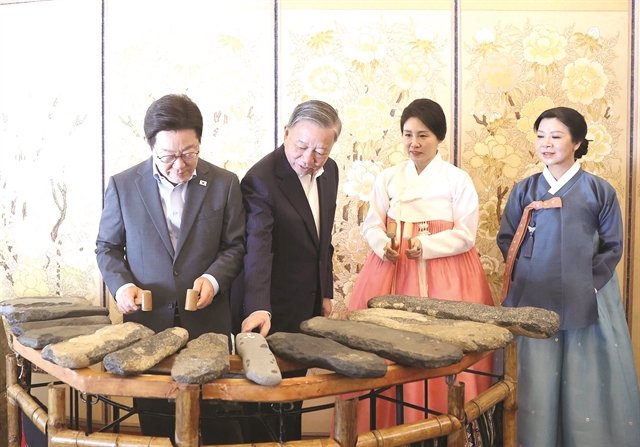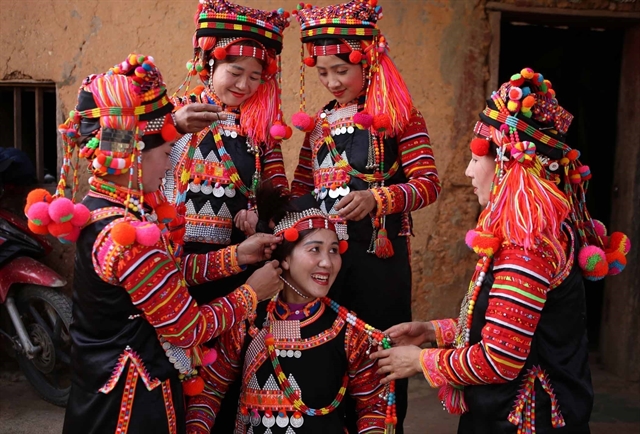 Sunday/Weekend
Sunday/Weekend

 |
| COLOURFUL PERFORMANCE: The xòe circle dance of the Hà Nhì ethnics reflecting the beauty of love is often performed by a group of boys and girls. VNA/VNS Photo Quý Trung |
Facing the risk of fading away due to outside cultural influences, the local authority in Mường Tè District in the northern mountain province of Lai Châu is piloting a project preserving the folk singing and dance of the Hà Nhì ethnic minority.
Ka Lăng Commune in the district has been chosen to implement the project by establishing a folk singing and dancing club.
On the first days of its operation in December last year, the club attracted 30 members. It is expected to expand, replicate and develop in other communes in Mường Tè.
With the support of the district's culture authority, the club collects and restores tunes of folk songs and dance figures, and organise classes to teach them to locals, particularly the young.
It has stirred up a cultural and artistic movement, contributing to preserving and promoting traditional culture and helping socio-economic development in the area.
 |
| GRACEFUL: A dance of the Hà Nhì ethnic women features farming work such as rice harvesting and fruit picking in the field. VNA/VNS Photo Quý Trung |
In their tradition, the Hà Nhì people compose songs and dances upholding their common spiritual belief.
Accordingly, their art is very diverse, with the use of various instruments. Many dances such as drum dance, cloth-weaving dance, hat dance and xòe dance reflect various aspects of their daily life.
Every day, members of the Hà Nhì folk singing and dancing club gather to practise and perform such dances as a way to entertain themselves and maintain their cultural tradition.
The hat dance is often the favourite chosen by club members to practise. To perform a hat dance, everybody, always women, needs a conical hat. Their feet should tap in rhythm with the gentle and flexible movements of their hands, to the tune of traditional music.
Next is a xòe circle dance which needs many people to participate. To connect with the divine world, xòe dance has long been an indispensable part of the Hà Nhì's spiritual life.
When the drums sound, the dancers put their hands together in front of them, and slightly bend their legs. A person holding a gong dance, depicting a scene of catching fish while the others stand in a circle, swinging their arms, stepping their feet to the beats of the drum and moving around from left to right and vice versa.
Each traditional song and dance of the Hà Nhì has its own unique identity. They demand simple movements without any strong turns or stepping like the dances of other ethnic groups.
Mạ Lý Phạ, the club leader, said folk songs and dances were essential to the Hà Nhì. They considered them as a spiritual dish of the day that had been associated with their daily life for hundreds of years.
 |
| GETTING READY: A group of Hà Nhì women prepares their costumes before a dance. VNA/VNS Photo Quý Trung. |
"To keep this beautiful tradition, the club will regularly encourage parents to send their children to the commune's cultural house to learn folk songs and dances to preserve this valuable national identity," he said.
The Hà Nhì people make up most of the population in Ka Lăng. They live in high mountains, near the border with China, so they are less influenced by the culture of other ethnic groups.
About 17,000 Hà Nhì people in more than 3,500 households live in Lai Châu, accounting for 3.6 per cent of the province's population. They live mainly in Mường Tè and Phong Thổ districts.
Folk songs and dances are regarded as a way of connecting the ethnic community which has no written language, and has retained its own cultural heritage through many ups and downs of historical and economic development.
The group has a diverse folk songs, musical instruments and dances, among them are many call-and-response songs and love duets that young couples often sing while dating.
When a young Hà Nhì man and his partner sing a duet during a date, the man often plays a leaf-horn or Jew’s harp. He picks a fresh leaf, folds it, and blows on it to make beautiful, clear birdlike sounds. He sometimes also blows into a straw and uses his two palms to make sounds.
At festivals, funerals, and weddings, the Hà Nhì often play drums, cymbals, and gongs with a quick rhythm. They have melodies for particular occasions, such as welcoming guests, inviting guests to drink wine, or celebrating newly harvested rice.
The dances reflect their customs and work, for example, the fabric-weaving dance. At the celebration of a new crop – the biggest festival at the beginning of the year, they perform a community religious dance while a shaman prays.
Lỳ Ló Hừ, vice chairman of the People's Committee of Ka Lăng, said the commune was honoured to be chosen as a place for establishing the Hà Nhì folk singing and dancing club.
"With the club establishment, the local authority aims to popularise the Hà Nhì ethnic culture not only in Ka Lăng but throughout the country. At the same time, the commune will ask the club and its leader to continuously mobilise all villages in Ka Lăng to restore and preserve national cultural identities," he said.
After nearly three months, members of the Hà Nhì folk singing and dancing club have participated in many important events in the district. In particular, the club includes some members who are elderly but very enthusiastic about collecting, restoring and teaching folk songs and dances to the younger generation.
Authority officials and experts say the club is an effective model, making an important contribution to preserving the cultural identity of the Hà Nhì ethnic group. The club has helped create a foundation for the locality to continue to replicate it to other ethnic groups in the area. It has also helped ethnic folk songs and dances develop as specific cultural products to serve community tourism.
According to Tống Văn Kem, deputy director of Culture and Information Department of Mường Tè, Ka Lăng was selected as the first locality in the district to restore and preserve folk songs and dances because the Hà Nhì people there still retain their rich cultural traditions despite facing travel and economic difficulties.
Kiều Hải Nam, vice chairman of the Mường Tè People's Committee, said the district would continue to improve the quality of human resources in culture and tourism, both in terms of state management, conservation and tourism business skills. VNS
Disable checkingPremium suggestionsDisable checkingPremium suggestionsDisable checkingPremium suggestions




